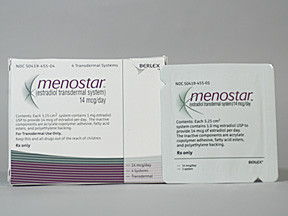ESTRADIOL WEEKLY - TRANSDERMAL (14 MCG/24 HR)
PHONETIC PRONUNCIATION: (ES-tra-DYE-ol)
COMMON BRAND NAME(S): Menostar
GENERIC NAME(S): estradiol
Uses
USES: This medication is a female hormone (estrogen). It is used by women after menopause to prevent bone loss (osteoporosis). However, there are other medications (such as raloxifene, bisphosphonates including alendronate) that are also effective in preventing bone loss and may be safer. These medications should be considered for use before estrogen treatment.
How to use ESTRADIOL WEEKLY - TRANSDERMAL (14 MCG/24 HR)
HOW TO USE: Read the Patient Information Leaflet if available from your pharmacist before you start using this medication and each time you get a refill. If you have any questions, ask your doctor or pharmacist. Peel off the backing from the patch and apply the patch to a clean, dry area of the lower stomach. Press the patch firmly in place for about 10 seconds to make sure it stays on. Do not apply the patch on the breast or on oily, broken, or irritated skin. Avoid applying the patch to areas of the skin where it might be easily rubbed off (such as the waistline). Use this medication as directed by your doctor. The patch is usually worn for 1 week and then replaced. Follow the dosing schedule carefully. When replacing your patch, make sure to apply the new patch to a different area. Wait at least 1 week before applying a patch to the same area. Fold the old patch in half with the sticky side together and throw away in the trash away from children and pets. Do not flush the patch down the toilet. If a patch falls off, reapply it to a different area. If the patch does not stick completely, then apply a new patch and wear it for the rest of the 7-day period. Do not wear 2 patches at the same time. Use this medication regularly to get the most benefit from it. To help you remember, change the patch on the same day each week. It may help to mark your calendar with a reminder.
Side Effects
Precautions
Interactions
Overdose
Images
Reviews
Faq for ESTRADIOL WEEKLY - TRANSDERMAL (14 MCG/24 HR)
Estradiol Weekly Transdermal patch is primarily used to relieve symptoms of menopause such as hot flashes, vaginal dryness, and night sweats.
The patch should be applied to clean, dry, and unbroken skin on the lower abdomen or buttocks. It should not be placed on the breasts or over any areas that are oily, irritated, or damaged.
The patch is typically changed once a week. It is important to follow the instructions provided by your healthcare provider and always change the patch on the same day each week.
Common side effects may include breast pain, headache, nausea, stomach cramps, and skin irritation at the application site. If you experience severe or concerning side effects, it is recommended to consult your doctor.
Yes, you can swim, bathe, or shower while wearing the patch. However, prolonged exposure to excessive heat or sunlight should be avoided, as it may affect the effectiveness of the patch.
The patch may take a few weeks to start providing maximum relief from menopausal symptoms. However, it is important to consult your doctor for personalized advice on the expected timeframe.
This medication is generally not recommended during breastfeeding. It is crucial to discuss your specific situation with your healthcare provider before using Estradiol Weekly Transdermal patch while breastfeeding.
Certain medications, herbal supplements, or even grapefruit juice may interact with Estradiol Weekly Transdermal patch. It is crucial to inform your healthcare provider about all the medications you are currently taking to avoid any potential interactions.
If you forget to change the patch on the scheduled day, apply a new patch as soon as you remember. However, do not apply two patches at the same time to compensate for the missed dose.
Warning
WARNING: Estrogens, either used alone or with another hormone (progestin), have rarely caused very serious side effects. Discuss the risks and benefits of hormone treatment with your doctor. Estrogens should not be used to prevent heart disease or dementia. Estrogens can increase the risk of cancer of the uterus (endometrial cancer). Taking a progestin as directed by your doctor can help decrease this risk. Tell your doctor right away if you have any unusual vaginal bleeding. In postmenopausal women, estrogens can increase the risk of cancer of the ovaries, stroke, dementia, and serious blood clots in the legs. Estrogens alone do not appear to increase the risk of breast cancer when used for up to 7 years. Estrogen, when used with a progestin, can increase the risk of heart disease (such as heart attacks), stroke, serious blood clots in the lungs/legs, dementia, and cancer of the breast/ovaries. The risk for serious side effects may depend on the dose of estrogen and the length of time it is used. Therefore, this medication should be used at the lowest effective dose and for the shortest amount of time. Discuss the use of this medication with your doctor regularly (for example, every 3 to 6 months) to see if you still need to use it. If you will be using this medication long-term, you should have regular complete physical exams (for example, once a year) as directed by your doctor. See also Notes section.
Disclaimer
IMPORTANT: HOW TO USE THIS INFORMATION: This is a summary and does NOT have all possible information about this product. This information does not assure that this product is safe, effective, or appropriate for you. This information is not individual medical advice and does not substitute for the advice of your health care professional. Always ask your health care professional for complete information about this product and your specific health needs.

No Reviews Yet